PLM as an innovation engine for automotive
Siemens, the 80 billion euro (Rs 613,500 crore) conglomerate and industrial technology solutions giant, has been empowering companies big and small, with its product lifecycle management (PLM) software.
Siemens PLM Software, whose technology is used by automakers and suppliers to collaborate, plan, design and validate the design and manufacturing processes of vehicles, is keen that the automotive industry fully benefits from all opportunities of digitalisation.
In a fast-moving industrial environment, staying afloat amid relentless competition requires an intrinsic focus on consumer demands, quick introduction of newer products and even offering customised options. The automotive industry is rapidly catching up with trends like those in the fashion or the consumer electronics space, where terms like ‘bespoke’ and ‘made to order’ enjoy much popularity.
To mitigate competition and get a shot in the arm, the need of the hour then is to switch over to digital solutions to offer this flexibility of choice and, at the same time, remain rational in the operation and production costs of these relatively smaller lot sizes. Moreover, technological forces like autonomous and electromobility are set to transform industry and also call for a need to take the digital path.
Siemens, the 80 billion euro (Rs 613,500 crore) conglomerate and industrial technology solutions giant, has been empowering companies big and small, with its product lifecycle management (PLM) software. The company’s software arm is able to offer a complete set of integrated solutions, ranging from mechanical, electronic and software, to bring a holistic menu to the table for manufacturing companies to streamline their businesses.
Siemens PLM Software, which has around 30 million automation systems in place at different client locations globally, is now looking ahead and enhancing its capabilities to aid development of futuristic technologies, be it in the area of product design, manufacturing or product testing. At its 2017 annual Siemens industry analyst conference (SIAC), held in Boston from September 5-8, the company shed light on its future PLM software roadmap towards industry 4.0, as well as offered a deep dive into the working of some of its highly used systems in product development across industries.
The backbone of its PLM software, Teamcenter, is the fundamental integrating platform working in the background to connect and bring together the multitude of operations of large companies including manufacturing OEMs and machine builders. It offers an immense level of data construction and sharing abilities, even including vendors and aftersales dealers into the network. Its recent feat has been the successful implementation of Teamcenter at Daimler, wherein Siemens PLM Software has been able to deploy a fully customised solution set for the automotive giant and run it without encountering any bugs, within a few months of the release of the extremely critical software.
Siemens says this concatenation and condensation of the entire value chain for a company has improved work efficiencies by up to 40 percent by reducing the human time consumed in doing regular tasks. Adding value to Teamcenter is a whole range of software solutions, spanning across product design and analysis, component costing, production design, production planning, supply chain, manufacturing, and aftersales, so as to virtually create a ‘Digital Twin’ of an entire project and simulate the product properties and end-to-end functioning of the core functions, before actually placing the project on real ground.
PRODUCT DESIGN & ANALYSIS

NX is one of the company’s strongest CAD tools, helping clients run their product designing activities on the software. Coupled with its CAE platform, Simcenter, which allows analysis within the system, utilising finite element modelling, computational fluid dynamics and multi-body dynamics, to virtually gauge the impact of forces using tools like NX CAE, LMS Virtual Lab and LMS Test Lab, engineers are able to further improvise product designs.
One successful application of its designing tools lies at Fiat Chrysler Automobiles (FCA). The automotive major, that recently introduced the Jeep Compass SUV in the Indian market, has seen the vehicle and powertrain engineering of the compact crossover take place entirely on NX and the group also relies heavily on Teamcenter to seamlessly flow the designs through its entire global work chain.

Siemens PLM Software has also made headway into electronic design automation (EDA) tools by recently acquiring leading E-CAD firm, Mentor Graphics, earlier in the year. The acquisition, which cost Siemens US$ 4 billion (Rs 25,600 crore), is set to bring a completely new expertise of integrated circuit (IC) design, along with the capabilities of designing PCBs and wire harnesses for automotive and aerospace systems.
With ICs set to play an extremely important role in future mobility solutions, which will include EVs and autonomous vehicles, the integration of such a strong division into its umbrella couldn’t have come at a better time, and making it fully prepared to offer a complete design package for its customers.
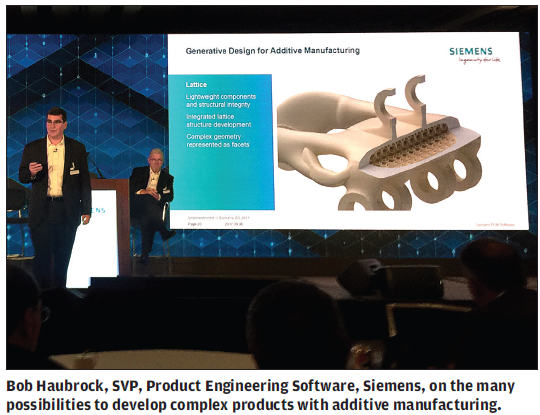
Also, ICs have emerged to be the core of smart products as well as IoT (Internet of Things), with companies like Tesla and Google working on developing complete systems on just a single chip. For instance, to tap into the huge potential of these semiconductor devices and cut down on its imports, in 2016, China proposed to invest a staggering 161 billion dollars over the next decade to strengthen its domestic IC business.
PROCESS ENGINEERING AND PLANT PRODUCTION
With a virtual environment, it is a boon to also allow process engineering work simultaneously with product planning right from the initiation of a project, and having the ability to merge both at a juncture and go strongly from thereon.
The Line Designer software helps to design complete assembly line layouts, taking into account the desired production volumes and optimum material flows. Also, Siemens’ Automation Designer tool helps create the automated section of the line, automatically generating PLC codes for the machines in place, which can be run and verified in the SIMATIC tool offered in Teamcenter.
Siemens PLM’s Technomatix software aids defining human ergonomics through time and motion study, as well as automatically generates the bill of process (BOP) from the bill of material (BOM), thus designing the production process on a digital platform, fully integrated with the 3-D product design.
After setting up a virtual manufacturing unit, each production step generated in the BOP can be virtually commissioned in Technomatix and the entire production can be simulated, so as to verify the proper functioning, performance and even ergonomics for the line associates, before going ahead with the start of production in actual real world.
Utilising augmented and virtual reality tools, the company has also been able to devise solutions to offer first-hand virtual experience of the assembly line, allowing real-time change implementation by simply dragging a machine placed at an existing location, and pulling it down to a new one and automatically getting the revised line layout.
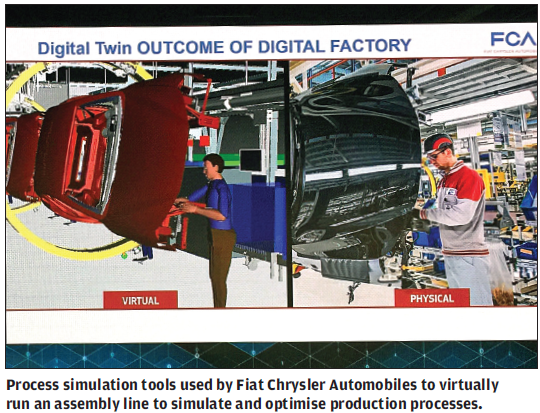
According to Tony Hemmelgarn, CEO, Siemens PLM Software, “It is only because of having a solid background in manufacturing of its own, Siemens has been able to re-invent its knowledge and offer a holistic digital twin of a product through its lifecycle, as opposed to many other industry solutions providers, who simply offer either the design or product analysis tools.”
The latest testament to the company’s highly integrated product lifecycle solutions is the switching of Japanese two-wheeler giant, Yamaha, over to Siemens PLM offerings. The company, which has been working with a global rival's software tools for quite some time, has announced moving of its entire global development divisions onto Teamcenter and NX for its designing, CAE and CAM activities.
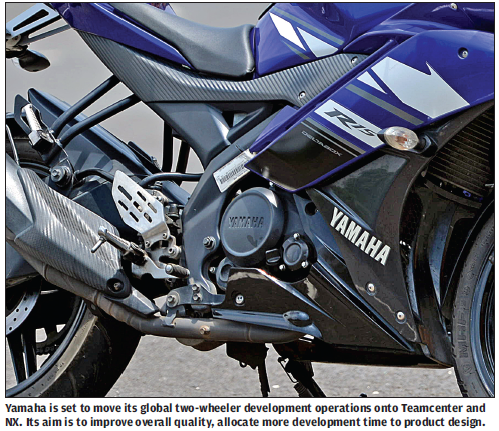
According to Hemmelgarn, “It takes quite compelling reasons to make customers like Yamaha, having sold 5.2 million motorcycles globally in 2015, to switch over to a new digital enterprise offering. The magnitude of change to undertake the activity is massive and needs huge amount of efforts. Yamaha’s key objectives were to improve its overall quality and allocate more development time to product design.”
Japanese Tier 1 component major Denso has also been utilising Siemens PLM tools for designing components for automotive air-conditioning, and has seen development times getting cut short by up to 66 percent.
ENABLING INDIA’S RACE TO INDUSTRY 4.0 AND MORE
Hemmelgarn says, with digitalisation lying ahead of the industry, companies big or small are facing the same set of challenges towards adoption of electrical, mechanical and software tools. While the scale might not be the same for organisations of different sizes, the complexity remains quite similar.
One of the biggest challenges is the inertia to keep continuing with the same set of systems and the reluctance to adopt change. In such a scenario, the best way to start walking the road to digitalisation is to start from somewhere. The easiest approach to that is to first employ best practices and start building data and managing data; then, later on, moving over to the intensive process of integrating the entire organisation.
Speaking on India’s position on Siemens’ global pedestal, Hemmelgarn said, “Siemens PLM Software visions India as a great destination offering huge growth potential for its business in the coming future as the company is already witnessing a lot of interest coming in from its customers, as well as the Indian government towards adoption of industrial digitalisation tools to be future-ready.”
“India will race to Industry 4.0 and digitalisation very quickly. Customers are going to demand it and, moreover, employees are going to demand it by not willing to work for a company being run on manual systems,” he added.
Enjoying robust brand equity, with the Siemens brand being very well recognised especially in India and China, the company is eyeing to leverage the huge advantage it already has, to grow its clientele and PLM software business in the Asia Pacific region. It also looks at the IoT space to enable a lot of business growth in the future, proposing a rapid growth curve ahead of it.
With a team of 1,200- odd engineers at one of its largest development centres in Pune, Siemens PLM also considers India to continue to remain a strong entity in the back-end development of all the core industrial software technologies for the future.
SOLUTIONS FOR CLOSED LOOP FEEDBACK MONITORING
With high levels of data integration and sharing capabilities, Siemens Teamcenter also allows for a large amount of information to be channelled back, once the product rolls out of the assembly line and reaches the end consumer.
With Mindsphere, its cloud integration system, Siemens PLM Software has created a completely new medium to route information from far-off sources, continuously monitor data to gain insight and to consistently refine product designs and services, using customer feedback over usage of products in real-world conditions.
Mindsphere is an open source ecosystem to allow developers to be able to create applications which could vary in their usage and cater to various needs of the servicing and the aftersales arena.
FUTURE OF DESIGN AND ADDITIVE MANUFACTURING
With surfacing of more and more complex products in the recent times, which are having high levels of electrical integration, there is a need of changing the way products are realised. With generative design taking over from the conventional methodologies, and with a strong surge towards additive manufacturing, industries are looking towards developing extremely complex designs, with lattice integrations, which were never possible before.
While generative design through convergent modelling also offers the benefits of lightweighting, additive manufacturing with immensely capable 3-D printers can drastically bring down development times, by coming handy in creating prototypes for product testing and analysis.
In its quest to scale up the use of additive manufacturing from prototype, right to the level of mass production of complex parts, Siemens has partnered with global print technology major, Hewlett Packard (HP) and has devised an extension module in NX, christened NX Additive Manufacturing (AM), to allow users to directly make a 3-D print of the designed product in NX via an HP Multi Jet Fusion 3-D printer.
This software extension aims to cut down on costs, as well as the time consumed in deciphering the 3-D printing codes from CAD data using third party software tools. Boasting up to 10 times faster printing as compared to other available 3-D printers in the market, HP aims to share the vision of industrialising additive manufacturing technology with Siemens and together, the two would be seen developing more synchronised technologies in future.
EYEING AUTONOMOUS VEHICLES
The world over, the automotive industry is set to witness big disruption in the coming years, with work on futuristic technologies like autonomous vehicles already in full swing across vehicle segments. With a highly integrated PLM ecosystem, Siemens has already been offering a host of tools for the design and development of these vehicles. But a major challenge remains the fool-proofing of autonomous driving technology, with the level of autonomy shooting up from the current stage of advanced driver assistance systems (ADAS) and reaching as high as Level-5, offering complete vehicle control by the set of on-board computers, cameras, sensors, radars and LIDARs.
A Roland Berger report on Autonomous Driving has it the business of sensors for autonomous functionality is set to see a boom, scoring a 25 percent CAGR through 2030. On the other hand, the design validation of autonomous technology will be a major cost component in the development of these vehicles, requiring close to 14.2 billion miles of testing being needed, as stated by Akio Toyoda at the 2016 Paris Motor Show.
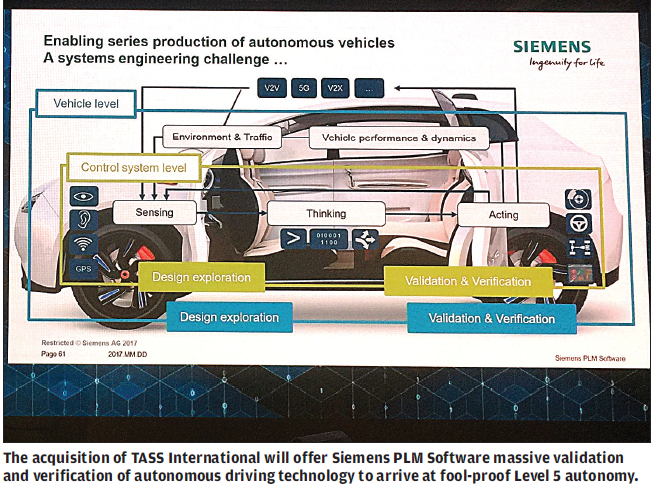
To offer a solution to this, Siemens PLM has announced to acquire Netherlands-based TASS International, a provider of automotive testing solutions, focused at autonomous vehicles, integrated safety, ADAS, as well as tyre modelling.
Siemens PLM Software aims to integrate TASS into its range of products and offer a completely digital enterprise solution set. TASS would enable development of safety-critical applications in the field of automated and connected driving and offer testing solutions to validate these critical technologies.
According to Dr Jan Mrosik, CEO, Siemens Digital Factory Division, “The automotive industry is a core focus for Siemens and our acquisition of TASS International will help us offer a complete digital enterprise solutions portfolio, enabling automotive companies to realise their digital transformation and fully benefit from all opportunities of digitalisation.
(This article was first published in the September 15, 2017 print edition of Autocar Professional)
RELATED ARTICLES
Branded content: HL Klemove inaugurates first Local ADAS Radar Manufacturing Unit in India, marks a significant achievement in “Make in India” initiative
The inauguration ceremony was held in the presence of Vinod Sahay, President and CPO of Mahindra & Mahindra Ltd. and Dr....
BluWheelz to 'Green Up' logistics sector
With their EVs-as-a-service solution, the startup is playing it smart with costs and looking to electrify the entire seg...
BRANDED CONTENT: Spearheading the EV revolution in India
Jio-bp is a joint venture between Reliance Industries and BP PLC where both entities have married international expertis...





 08 Oct 2017
08 Oct 2017
 15594 Views
15594 Views



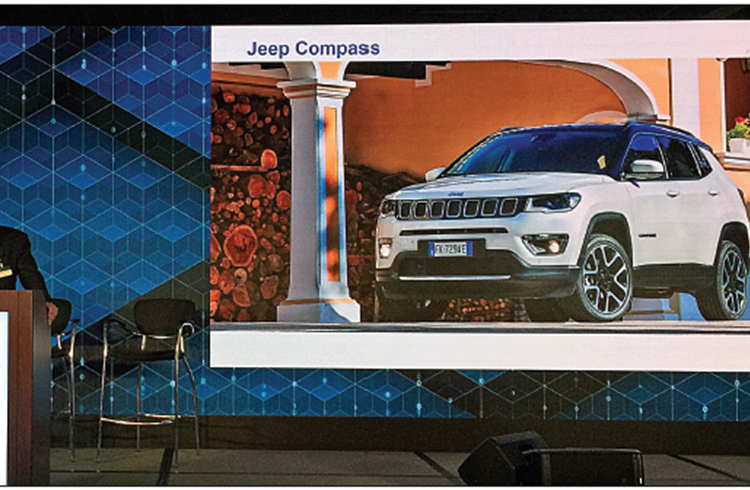

 Autocar Pro News Desk
Autocar Pro News Desk




